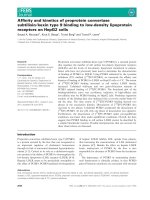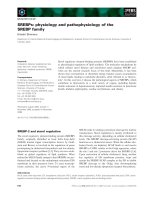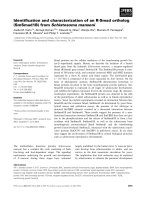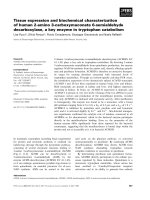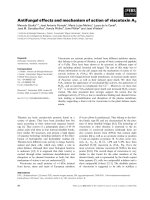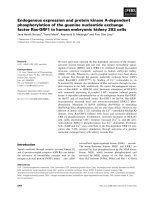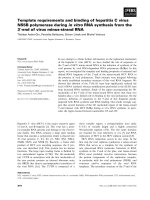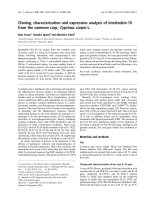Báo cáo khoa học: Cloning, expression and interaction of human T-cell receptors with the bacterial superantigen SSA ppt
Bạn đang xem bản rút gọn của tài liệu. Xem và tải ngay bản đầy đủ của tài liệu tại đây (357.25 KB, 9 trang )
Cloning, expression and interaction of human T-cell receptors
with the bacterial superantigen SSA
Mauricio C. De Marzi
1
, Marisa M. Ferna
´
ndez
1
, Eric J. Sundberg
2
, Luciana Molinero
3
, Norberto W. Zwirner
3
,
Andrea S. Llera
1,
*, Roy A. Mariuzza
2
and Emilio L. Malchiodi
1
1
Ca
´
tedra de Inmunologı
´
a and Instituto de Estudios de la Inmunidad Humoral (IDEHU), CONICET, Facultad de Farmacia y
Bioquı
´
mica, Universidad de Buenos Aires, Argentina;
2
Center for Advanced Research in Biotechnology, W. M. Keck Laboratory for
Structural Biology, University of Maryland Biotechnology Institute, Rockville, MD, USA;
3
Laboratorio de Inmunogene
´
tica,
Hospital de Clı
´
nicas Jose
´
de San Martı
´
n, Facultad de Medicina, Universidad de Buenos Aires, Argentina
Superantigens (SAgs) are a class of disease-causing and
immunostimulatory p roteins o f b acterial or viral o rigin t hat
activate a large number of T-cells through interaction with
the Vb domain of T-cell receptors (TCRs). In this study,
recombinant TCR b chains were constructed with human
variable domains Vb5.2, Vb1andVb2.1, expressed as
inclusion bodies, refolded and purified. The Streptococcus
pyogenes SAg SSA-1 was cloned and expressed a s a soluble
periplasmic protein. SSA-1 was obtained both as a monomer
and a dimer t hat has an intermolecular disulfide bond. We
analyzed the biological activity of t he recombinant SAgs by
proliferation assays. The results suggest that SSA dimeriza-
tion occludes the TCR interac tion site. Naturally occurring
SSA dimerization was a lso observed in supernatants of
S. pyogenes isolates. An SSA mutant [SSA(C26S)] was
produced to eliminate the Cys responsible for dimerization.
Affinity assays using a resonant biosensor showed that both
the mutant and monomeric wild type SSA have affinity for
human Vb5.2 and V b1withK
d
of 9–11 l
M
with a fast k
ass
and a moderately fast k
diss
. In spite of the reported stimu-
lation of V b2.1 bearing T-cells by SSA, we o bserved no
measurable interaction.
Keywords: affinity constant; biosensor; SSA; Streptococcus
pyogenes; T-cell receptor.
T-lymphocytes recognize a wide variety of antigens through
highly diverse cell-surface glycop roteins known a s T-cell
receptors (TCRs). These disulfide-linked heterodimers are
comprised of a and b (or c and d) chains that have variable
(V) and constant (C) regions homologous to those of
antibodies. Unlike antibodies, which recognize antigen
alone, ab TCRs recognize antigen only in the form of
peptides bound to major histocompatibility complex (MHC)
molecules. In addition TCRs interact with a class of viral and
bacterial proteins known as superantigens ( SAgs).
SAgs are microbial toxins with potent immunostimulatory
properties. They circumvent the normal mechanism for
T-cell activation by binding as unprocessed molecules t o
MHC class II and TCR. T he resulting trimolecular comple x
activates a large fraction of the T-cell population (5–20% of
all T-cells), c ompared with conventional peptide antigen
specific activation (0.01–0.001%). The activated T-cells
release massive amounts of inflammatory cyto kines such as
IL-2, TNF-a and IFN-c, contributing to the symptoms
caused by SAgs, which can lead to lethal toxic shock [1]. SAgs
have been implicated in a number of a utoimmune diseases
such as diabetes mellitus, rheumatoid arthritis and m ultiple
sclerosis, by activating T-cells specific for self-antigens [2,3];
however, t he best characterized d iseases c aused by SAgs a re
food poisoning and toxic shock syndrome ( TSS) [4,5].
SAgs produced by several strains of Staphylococcus
aureus and Streptococcus pyogenes are structurally and
immunologically the best c haracterized to date [6], although
the crystal structures of SAgs from Mycoplasma arthritidis
and Yersinia pseudotuberculosis have been solved recently
[7,8]. Bacterial S Ags are 22–29 kDa molecules that are
resistant to proteases and heat denaturalization. They can
be absorbed by epithelial cells as immunologically intact
proteins [1,9]. Most SAgs share a common three-dimen-
sional structure, although their amino acid sequences are
highly variable. The structure of b acterial SAgs shows two
globular domains: a small N-terminal domain w ith an O B
fold (Ôoligosaccharide/oligonucleotide-bindingÕ), and a large
C-terminal domain with a b-grasp motif [10,11]. The TCR
binding site on the SAg is situated in a cleft between the t wo
domains [12,13]. In addition, SAgs have one or two b inding
sites for MHC class II: a low affinity site, a nd a higher
Correspondence to E. L. Malchiodi, Junı
´
n 956 4° P Inmunologı
´
a (1113)
Buenos Aires, Argentina. Fax: +54 11 4964 0024,
Tel.: +54 11 4964 8260, E-mail: emalchio@ffyb.uba.ar
Abbreviations: C, constant region; DTT, dithiothreitol; MHC, major
histocompatibility c omplex; NTA, nitrilotriacetic acid; PBMC,
peripheral blood mononuclear c ell; SAg, superantigen; SEC3, Sta-
phylococcal exterotoxin C3; SSA, Streptococcal superantigen; SSAm,
SSA monomer; SSAd, SSA dimer; SSAia, SSA–iodoacetamide; TCR,
T-cell receptor; TSS, toxic shock synd rome; V, variable region; wt,
wild ty pe.
*Present address: F un dacio
´
n Instituto Lel oir, C ONICE T, B uenos
Aires, A rge ntina.
(Received 26 May 2004, rev ised 20 A ugust 2004,
accepted 26 August 2004)
Eur. J. Biochem. 271, 4075–4083 (2004) Ó FEBS 2004 doi:10.1111/j.1432-1033.2004.04345.x
affinity site on the opposite f ace of the molecule that is Zn
2+
dependent [14,15].
The proinflamatory and procytotoxic properties of SAgs
are r esponsible for the increased interest in these molecules
in the treatment of several pathologies and because of the
potential use of the toxins as biological weapons. Alteration
of their MHC and TCR binding capacity by site directed
mutagenesis could be useful in the development of vaccines
and in cancer therapy. SAgs with mutated TCR and/or
MHC binding sites could be employed as vaccines against
TSS and food poisoning to generate protective antibodies
without systemic effects [ 16,17].
Streptococcal s uperantigen (S SA) is a 260 residue protein
produced by S. pyogenes that can generate symptoms
similar to TSS [18]. SSA shares more molecular p roperties
with the staphylococcal enterotoxins SEB and SEC than
with other streptococcal SAgs [19]. Cellular proliferation
studies show disagreement about which TCR bearing T-cell
subsets are expanded by interaction with SSA. Some
authors indicated clonal expansion of T-cells bearing
human Vb3, Vb12, Vb17 and Vb19 [20]. Others showed
proliferation of human T-cells bearing Vb1, V b2, Vb3,
Vb5.2, Vb12, Vb15 and Vb17 domains and found differ-
ences in the stimulation pattern between native and
recombinant SSA, or even between variants (SSA-1 or
SSA-2) [ 19,21].
To investigate SSA–TCR binding affinity, we expressed
these molecules in high yield prokaryotic systems that
allow u s to obtain enough recombinant protein t o conduct
binding studies. In order to avoid dimerization, SSA Cys26
was mutated to Ser [SSA(C26S)]. Different SSA prepara-
tions were used to study T-cell proliferation capacity with
human peripheral blood mononuclear cells (PBMCs). The
binding of SSA and mutant C26S to soluble TCR b-c hain
molecules Vb1, V b2.1 and V b5.2 was measured in real time
by a Ôresonant mirrorÕ optical biosensor method.
Materials and methods
Reagents
All chemicals were of analytical grad e and purchased from
Sigma (St. Louis, MO). Restriction enzymes, Taq DNA
polymerase, T4 ligase and buffers for cloning were pur-
chased from New England Biolabs, Inc. (Beverly, MA).
Ultra pure agarose was purchased from Gibco BRL-Life
Technologies ( Rockville, MD).
Recombinant TCR b chains
Human V b5.2 ( hVb5.2) was fused to a mouse constant
b chain domain (mCb15) to facilitate purification and
increase yield [22,23]. Chimeric hVb5.2mCb15 was cloned
into the kanamycin resis tant expression v ector pET26b and
expressed as inclusion bodies [12] in Escherichia coli
BL21(DE3) (St ratagene, L a Jolla, CA). Two other b chains,
hVb2.1hCb2 and hVb1hCb2 ( genes kindly provided by
U. Utz and R. P. Sekaly, University of Montreal, Canada),
were clone d b etween the NdeIandEcoRI restriction sites of
the pET17b expression vector and expressed in E. coli
BL21(DE3) as inclusion bodies. Glycerol stocks of these
clones w ere maintained at )70 °C.
TCR production and purification
Luria–Bertani broth (LB) agar plates containing
50 lgÆmL
)1
of kanamycin o r 100 lgÆmL
)1
of ampicillin
were incubated overnight at 37 °C from transforming
BL21(DE3) glycerol stocks. One litre of LB medium was
inoculated with 10 mL overnight culture and grown with
shaking at 37 °Ctoanattenuanceof0.8at600nm.TCR
expression was induced with 1 m
M
isopropyl thio-b-
D
-
galactoside for 3–5 h. Cells were harveste d by centrifugation
at 2100 g for 20 min. The bacterial pellet of hVb5.2mCb15
was resuspended in lysis buffer [50 m
M
Tris/HCl, pH 7.5,
1m
M
EDTA, pH 8, and 1 m
M
dithiothreitol (DTT)] and
passed through a French press twice at 1300 psi. The lysate
was centrifuged at 7700 g for 15 min and t he pelleted
inclusion bodies were washed four times with 0.5% (v/v)
Triton X-100 and 100 m
M
NaCl in lysis buffer. The
inclusion bodies were then washed with 2
M
urea in 2
M
NaCl, 50 m
M
Tris/HCl, pH 7.5, 1 m
M
DTT, with 4
M
urea
in the same b uffer, and finally with 100 m
M
Tris/HCl,
pH 7.5, 1 m
M
EDTA and 1 m
M
DTT. Inclusion bodies
were then solubilized in 8
M
urea, 100 m
M
Tris/HCl,
pH 7.5, 10 m
M
EDTA and 1 m
M
DTT. Concentration of
solubilized inclusio n bodies was estimated in a Coommassie
Blue stained SDS/PAGE, using different concentrations of
BSA a nd then diluted 1 : 5 in 6
M
guanidine, 10 m
M
acetate
buffer, pH 4.2, and 10 m
M
EDTA. Denatured b chain was
added dropwise to the renaturation buffer (1
M
arginine/
HCl, pH 7.5, 2 m
M
EDTA, 100 m
M
Tris/HCl, pH 7.5,
6.3 m
M
cysteamine, 3.7 m
M
cystamine) under vigorous
stirring to a final concentration of 20–50 lgÆmL
)1
during
48 h at 4 °C.
Refolded hVb5.2mCb15 was concentrated and dialyzed
extensively against NaCl/P
i
and affinity purified using the
anti-mouse Cb mAb (H57-597) [24,25]. Alternatively,
hVb5.2mCb15 was run on a Superdex 200 FPLC column
(Amersham Pharmacia Biotech AB, Uppsala, Sweden) to
eliminate aggregated material that could interfere with
affinity measurements [26]. hVb5.2mCb15 was dialyzed
against 50 m
M
Mes, pH 6, and further p urified o n a Mono-
S cation-exchange FPLC column (Amersham Pharmacia
Biotech AB) equilibrated with 5 0 m
M
MES, pH 6, and
developed with a linear NaCl g radient. The purified protein
was dialyzed against NaCl/P
i
and concentrated to
2mgÆmL
)1
.
hVb2.1hCb2 and hVb1hCb2 were also produced as
inclusion bodies and refolded at pH 8.5. Purification steps
included g el filtration on a Superdex 200 FPLC column and
further purification on a Mono Q anion-exchange FPLC
column (Amersham Pharmacia Biotech AB) equilibrated
with 50 m
M
Tris, p H 8.5, a nd developed with a linear N aCl
gradient.
Streptococcus pyogenes
superantigen (SSA)
The ssa-1 gene was PCR amplified from Streptococcus
pyogenes DNA (ATCC 51500 strain) o r clinical isolates of
S. pyogenes with 5¢ and 3¢ terminal oligonucleotides specific
for the region encoding the mature protein (5 ¢ primer,
5¢-CATGCCATGGCCAGTAGTCAGCC TGACCCTACT
CCAG-3¢;3¢ primer, 5¢-CGCGCGGGATCCTTAGTG
ATGGTGATGGTGATGGGTGACCGGTTTTTTGG
4076 M. C. De Marzi et al.(Eur. J. Biochem. 271) Ó FEBS 2004
TAAGGTGAAC-3¢)thathadNcoIandBamHI restriction
sites, respectively. The amplified DNA was purified by
agarose gel and ligated without previous digestion in the
pGEM T Easy vector (Promega, Madison, WI). Ligation
products were transformed i nto E. coli DH5a (Str atagene).
pGEM T-ssa was digested with BamHI and NcoIandthe
agarose gel purified product was cloned into the NcoI/
BamHI site of the bacterial expression ve ctor pET 26b
(Novagen, Madison, WI). E. coli DH5a cells were trans-
formed with ligation products for amplification. Expression
was carried out in E. coli BL21(DE3) as periplasmic
protein. All transformed clones were selected in 50 lgÆmL
)1
kanamycin p lates.
An SSA mutant where the Cys26 r esidue was replaced for
a Ser [SSA(C26S)] was obtained by site-directed mutagen-
esis in order to avoid dimerization through intermolecular
disulfide bond formation. Primers used for first PCR were:
5¢ primer, 5¢-CATGCCATGGCCAGTAGTCAGCCTGA
CCCTACTCCAG-3¢ and 3¢ primer, 5¢-GGTTATCATA
TAAAGATCTCAAATTACCC-3¢, for the second PCR
the primers were: 5¢ primer, 5¢-GGGTAATTTGAGATC
TTTATATGATAACC-3¢ and 3¢ primer, 5¢-CGCGCGG
GATCCTTAGTGATGGTGATGGTGATGGGTGACC
GGTTTTTTGGTAGGTGAAC-3¢.ThethirdPCRwas
carried out using PCR products, the first PCR 5¢ primer and
the s econd 3¢ primer. The final amplified DNA was ligated
into pET26b and expressed in E. coli BL21(DE3) cells.
Glycerol stocks were maintained at )70 °C.
SSA and SSA(C26S) DNA sequence analysis
Both wild type SSA (wtSSA) and mutant SSA(C26S) DNA
were sequenced with a Thermo Sequenase Cy5.0 Dye
Terminator Cycle Sequencing Kit (Amersham Pharmacia
Biotech A B) as indicated by the manufacturer.
Superantigen expression and purification
LB agar plate cultures with 50 lgÆmL
)1
of kanamycin
were grown overnight at 37 °C from SSA or SSA(C26S)
transformed B L21(DE3) glycerol stock. One litre of LB
was inoculated with 10 mL overnight culture and incu-
bated at 30 °C with shaking to an attenuance of 1.0 at
600 nm (3–6 h). SAg expression was induced with 0.2–
0.4 m
M
isopropyl thio-b-
D
-galactoside for 5 h. Cells were
harvested from induced cultures by centrifugation a t
7300 g for 10 min. The periplasmic fraction, which
contained most of the SAg, was obtained by osmotic
shock as described previously [27]. Briefly, the bacterial
pellet was resuspended in 50 mL o f Tes buffer (200 m
M
Tris/HCl,pH8,500m
M
sucrose and 0.5 m
M
EDTA) on
ice for 30 min and centrifuged for 10 min at 12 000 g.
The supernatant was saved on ice and the pellet was
resuspended in 50 mL of a 1 : 5 dilution of Tes and
centrifuged as before. Both supernatants were mixed and
dialyzed against NaCl/P
i
.His
6
-tagged protein was further
purified by Ni
2+
–nitrilotriacetic acid (NTA) a ffinity
chromatography as described by the manufacturer
(Qiagen), washed with 20 m
M
imidazole 0.5
M
NaCl,
0.1
M
Tris/HCl, pH 8.5, and 20 m
M
imidazole, 0.5
M
NaCl, 0.1
M
Tris/HCl, pH 8.0. The protein was elu ted
with 0.3
M
imidazole, pH 7.5, 10 m
M
EDTA [27]. Further
purification of SAgs was performed using a size exclusion
Superdex 75 column (Amersham Pharmacia Biotech AB)
equilibrated with 50 m
M
Tris, pH 7.5, 150 m
M
NaCl and
finally with a Mono-S c ation exchange column (Amer-
sham Pharmacia Biotech AB) equilibrated with 50 m
M
MES, pH 6.0, and developed using a linear NaCl
gradient. About 15 mg of purified protein per litre of
culture medium was obtained.
Reduction and alkylation of SSA
SSA after Ni–NTA purification was reduced with 10 m
M
DTT for 2 h at 25 °C. Solid iodoacetamide was then added
and alkylation was allowed to proceed in the d ark at 25 °C
for 30 min. The reduced and alkylated protein w as dialyzed
into NaCl/P
i
and analyzed by SDS/PAGE and immuno-
blot. SSA–iodoacetamide (SSAia), with the free Cys
blocked, was purified as a monomer by S-75 column
(Amersham Pharmacia Biotech AB) with 50 m
M
MES,
pH 6, 150 m
M
NaCl.
SDS/PAGE and immunoblotting
Proteins were analyzed by SDS/PAGE on a 12.5% gel.
Previously all the proteins were denatured in SDS buffer
with or without DTT and boiled for 3 min before electro-
phoresis. Proteins ban ds were visualized using Coommassie
Brilliant Blue. SAgs were also analyzed by immunoblotting
using an anti-His mAb (Sigma) o r a rabbit anti-SSA. Rabbit
polyclonal antisera were obtained by immunization with
1mgÆmL
)1
of SSAia mixed with a volume of complete
Freund’s adjuvant. Boosts were administered on day 7 , 14
and 28. Sera obtained on day 35 were diluted 10-fold and
tested by ELISA and immunoblot. Experiments using
animals were c arried out following rules from the Natio nal
Council of Research (CON ICET).
T-cell proliferation assay
Heparinized blood was obtained from healthy blood
donors, previously test ed for antibodies against SSA by
ELISA with negative results, and diluted with RPMI
1640 or NaCl/P
i
(1 : 1, v/v). Blood samples were t aken
with the understanding and written consent of each
subject. Twenty millilitres of the diluted blood was slowly
added to 10 mL of Ficoll-Paque
TM
(Amersham Pharma-
cia Biotech AB) in a 50 mL tube and centrifuged at
400 g for 20 min. The PBMCs contained i n the inter-
phase were washed with 15–20 mL of RPMI and
centrifuged for 10 min at 200 g; the pellet was resus-
pended in 5 mL of RPMI with 10% o f human serum with
2m
M
glutamine, 100 UÆmL
)1
penicillin, 100 lgÆmL
)1
streptomycin and 1 m
M
pyruvate. The PBMC popula-
tion was counted with Trypan Blue in a Newbauer
camera.
Purified cells (10
6
per well) were cultured in flat-bottom
96-well plates in the presence of varying dilutions of
staphylococcal exterotoxin C3 (SEC3), SSA monomer
(SSAm), SSA dimer (SSAd), SSAia or SSA(C26S), in
100 lL of complete culture medium. Phytohaemagglutinin
(1 lgÆmL
)1
) was used as positive control. After 48 h
incubation at 37 °C in 5% (v/v) CO
2
,1mCiperwellof
Ó FEBS 2004 Interaction of human TCR with superantigen SSA (Eur. J. Biochem. 271) 4077
[
3
H]thymidine was added for the next 18 h and then
harvested onto glass fibre filters. Incorporation of radio-
activity was then measured using a Liquid Scintillation
Analyzer 1600 TR (Packard, Canberra, Australia). All
measurements were made in triplicate.
Binding analysis
The interaction of soluble b chains with SAgs was monit-
ored in a resonance mirror with an IAsys instrument
(Labsystem, Cambridge, UK) biosensor, which allows
determination of real time interactions between two mole-
cules [ 28].
b Chains or SAgs ( 100 lgÆmL
)1
) w ere d ialyzed against
10 m
M
sodium acetate, pH 5.5, and coupled to the
carboxymethyl-dextran cuvettes (Labsystems) using the
Amine C oupling Kit as described by the manufacturer
[29]. The activation and immobilization p eriods were set
between 5 and 7 min to couple the desired amount of
proteins yielding between 400 and 600 arc s econds.
Micromolar concentrations of SAgs [SSA and
SSA(C26S)] or b chains (Vb1, V b2.1 and V b5.2) were
dialyzed against NaCl/P
i
, pH 7.5, containing 0.05% (v/v)
Tween 20. Twofold dilutions were made in the same buffer
(160, 80, 40, 20, 10, 5, 2.5 and 1.25 l
M
). All binding
experiments were performed at 25 °C. Dissociation was
carried out in (NaCl/P
i
)/Tween 20. Pulses of 10 m
M
HCl
were used to regenerate the s urface. All the experiments
were repeated at least three times.
Dissociation constants (K
d
) were determined under
equilibrium binding conditions using Scatchard plots after
correction for nonspecific binding, in which the p roteins
were passed over blocked, empty cuvettes, as described
previously [26,30]. The off rate (k
diss
) was determ ined using
the software
FASTPLOT
and the on rate (k
ass
) was obtained
as k
ass
¼ k
diss
/K
d
.
Results
TCR b chains
Our TCR b chain expression systems y ielded 35–50 mgÆL
)1
of inclusion bodies. After refolding and concentration, a
first purification step was carried out for chimeric
hVb5.2mCb15 with a H57-597 mAb affinity column or
with an S-200 column, followed by ion exchange chroma-
tography. Typically, a final yield of 1–2 mgÆL
)1
of culture
for t he refolded b chain TCR constructs were obtained.
Superantigen
Our expression system produced 15 mgÆL
)1
of folded wild
type SSA-1. After Ni–NTA p urification, two bands of
protein were observed in SDS/PAGE (Fig. 1A). The
weaker band has an apparent molecular mass in agree-
ment with the theoretical value calculated from the amino
acid sequence; the stronger band has about twice the
expected molecular mass. Both bands were reactive in
immunoblotting with anti-His mAbs and an anti-SSA
serum prepared in rabbits (Fig. 1C), indicating the
presence of two recombinant species. The dimer/mono-
mer mixture could not be efficiently resolved using an
S75 column, yielding a fraction with 80% monomer
(SSAm) and another containing 90% dimer (SSAd)
(Fig. 1B). To determine whether an intermolecular disul-
fide bond mediated dimerization, Ni–NTA purified SSA
was gently treated with DTT and the resulting free Cys
residues were alkylated with iodoacetamide. As shown in
Fig. 1B, reduction and alkylation produced only one
band in SDS/PAGE with the expected molecular mass of
the monomer.
Considering that dimerization could occlude the TCR
binding site, we also constructed a mutant SSA by site-
directed mutagenesis. Analysis of the three-dimensional
structure of SSA [31] showed that: (a) SSA has five Cys,
of which two (Cys93 and Cys108) form a disulfide bond,
which is present in most of the known SAgs; (b) the
position of Cys101 was not determined in the crystal
structure o f SSA because it forms part of a loop that
could not be modeled; and (c) Cys158 would not be
exposed at the SSA surface. The putative TCR binding
site of SSA is not known y et but an analysis based on
homology with the TCR binding site of SEB and SEC3
[12,13,19,21], showed that Cys26 is not only exposed in
the protein surface (Fig. 2), but would be in the putative
TCR binding site. Consequently, a point mutation was
introduced to replace Cys26 by Ser, which was confirmed
by DNA sequencing. As can be seen in Fig. 1B–D,
expression of the mutant yields only monomeric SSA,
free of dimer.
T-cell proliferation assay
We next analyzed the ability of recombinant SSA to
stimulate human T-cells. All SSA preparations yielded
Fig. 1. SDS/PAGE and immunoblotting analysis of SSA. (A) 12.5%
SDS/PAGE of SSA after N i–NT A purification (Lane 3) and the s ame
sample treated with DTT (Lane 2). A TCR b chainwithasimilar
molecular mass is shown as a marker ( Lane 1). (B) 12.5% SDS/PAGE
of differen t S SA preparations. Lane 1: SSA reduced and alkylated wit h
iodoacetamide (SSAia); Lane 2: SSA preparation enriched in dim er
after purification o n S75 F PLC (SSAd); Lane 3: C26S mutant
(SSA
C26S
) and Lane 4: SSA preparation enriched in m onomer
(SSAm). (C and D) Imm unoblots of SSAia, wtSSA and SSA(C26S)
using a commercial anti-His mAb or rabbit anti-SSA sera, respectively.
4078 M. C. De Marzi et al.(Eur. J. Biochem. 271) Ó FEBS 2004
dose-dependent T-cell proliferation, analyzed by
[
3
H]thymidine incorporation (Fig. 3). SSAm and the
mutant SSA(C26S) caused greater proliferation than the
positive control SAg, SEC3. Both SSAd and SSAia
produced T-cell proliferation > 100-fold lower than
SSAm or SSA(C26S) (Fig. 3).
Affinity assays
Equilibrium and kinetic parameters for SSA binding to
different TCR b chains were determined in a resonance
mirror using an IAsys instrument biosensor. SSA affinity
for the immobilized TCR Vb5.2 was first measured and
data were evaluated by Scatchard plot analysis. Dissociation
constants w ere estimated from the n egative reciprocal of the
slope of the fitted line yielding a K
d
value of 153 l
M
(result
not shown). Considering that the immobilization process
could alter the molecule, rendering inaccurate results, and
the fact t hat a high proportion of SSA was a dimer that may
have the T CR binding site blocked, the p urified SSAm f orm
and the mutant SSA(C26S) were immobilized in a dextran
matrix.AsshowninFig.4,TCRVb5.2 concentration-
dependent binding to both SSA species w as observed. The
association rate constant (k
ass
) was too f ast to b e accurately
measured. On the contrary, the dissociation rate constant
(k
diss
) could be determined using higher concentrations of
SSA. Therefore, affinities (K
d
) were determined under
equilibrium binding conditions, i n which we took report
points for Scatchard analysis 5 min a fter injection. The k
ass
were further calculated using equation K
d
¼ k
diss
/k
ass
(Table 1). Immobilization o f the SAgs instead of TCRs
yielded a higher binding constant of the former, which was
similar for both complexes, wtSSA–Vb5.2 a nd SSA(C26S)–
Vb5.2.
Different c oncentrations of human Vb2.1 and Vb1TCRs
were also used to measure the binding to the immobilized
SSAm and SSA(C26S). Vb1 showed a pattern of association
and dissociation rates similar to the one obtained with
Vb5.2 ( Fig. 5), yielding K
d
s of t he same order of m agnitude
(Table 1). On the contrary, no binding of Vb2.1 TCR to
SSA was detected even using a 160 l
M
concentration of b
chain. Trials using higher c oncentrations were u nsuccessful
due to nonspecific aggregation of t he Vb2.1 T CR.
Discussion
The expression and purification of TCRs using either
prokaryotic or eukaryotic systems had been troublesome
for several years, delaying structural and other st udies. The
TCR b chain constructions we engineered allowed us to
obtain large amounts of recombinant protein as inclusion
bodies that could be refolded properly and used for SAg
binding experim ents.
SAg constructs generated large amounts of properly
folded protein, but monomer and dimer forms w ere
obtained in the wtSSA preparation. Dimerization as a
prerequisite for T-cell activation has been suggested for
other SAgs, such as SED [32], SPEC [33] and more recently
SPEA [34]. In SED and SPEA the presence of Zn
2+
plays
an important role in dimerization; Zn
2+
was found in the
crystal structure of SPEC after soaking the crystal in a z inc
solution, but dimerization of this SAg also occurred in
absence of Zn
2+
. On the other hand, SSA, which has not
been reported t o have a zinc-binding site, dimerized through
Cys. Among th e known S Ags, most have two Cys residues
forming a n intramolecular b ridge. There are four SAgs with
Fig. 3. Dose-dependent T-cell proliferation by the different SAg prepa-
rations. AsindicatedinMaterialsandmethods,[
3
H]thymidine incor-
poration was measured in a liquid scintillation analyzer. Both SSAm
and SSA(C26S) produce more than 100-fold higher T-cell proliferation
than SSAd and SSAia. SEC3 was inc lude d a s a positive control.
Fig. 2. SSA three-dimensional structure. Residue Cys26 of SSA is
contiguous with its putative b in ding interface w ith the T-cell receptor.
The common residues of SEB and SEC3 that form their respective
molecular i nterfaces with mVb8.2 are largely conserved in SSA. These
include r esidues that are stric tly conserved between SEB, SEC3 a nd
SSA (shown in b lue on the SSA molecular surface), as well as residues
that vary be tween t he three superantigens (sho wn in cyan). Residue
Cys26 is shown in red.
Ó FEBS 2004 Interaction of human TCR with superantigen SSA (Eur. J. Biochem. 271) 4079
no Cys in the mature protein sequence (TSST-1, SPEB,
SMEZ1 and 2), three have one Cys (SEI, SEK and SPEC),
two have three Cys (SEG and SPEA) and only SSA has
more than that, five Cys. As discussed later, the fact that
SSA has two Cys r esidues (Cys26 and Cys101) expo sed to
solvent would facilitate formation of an intermolecular
disulfide bond, as observed in r ecombinant wtSSA.
In order t o a ddress w hether dimerization is an artefact of
overexpression in E. coli we analyzed the supernatant of
several S. pyogenes isolates by immunoblotting using a
rabbit SSA antiserum. As shown in Fig. 6 there is high
degree of naturally occurring dimerization in eight out of
ten supernatants studied, which reverted upon DTT treat-
ment of the samples. Further studies are necessary to
understand the biological significance of the natural dime-
rization.
The presence of a dimer in wtSSA, which could not be
completely separated from the monomer, prompted us to
follow two strategies to obtain a single species; reduction and
alkylation, and mutation of the Cys implicated in the
intermolecular disulfide b ridge. Analysis of t he three-dimen-
sional structure of SSA [31] to determine which of the
remaining three Cys residues could be i mplicated in the
intermolecular disulfide bridge, showed that Cys158 is
located in the core of the protein and is therefore not exposed
to solvent. Cys101 could n ot be identified in the SSA
structure because it forms part of the flexible d isulfide loop of
positions 93–110 with high intrinsic mobility [31]. Cys26 is
exposed to solvent in the cleft b etween the s mall and large
domains, which has been shown to b e the TCR binding site in
other SAgs. Point mutation of Cys26 to Ser prevented dimer
formation and allowed TCR interaction studies.
Initial binding experiments using a biosensor gave an
apparent dissociation constant for the immobilized TCR
Vb5.2 of wtSSA of 153 l
M
, w hich is near the lower limits o f
the known SAg–TCR interactions [26]. To avoid any
altered K
d
determination due to the immobilization p rocess
of the TCR, we immobilized wtSSA to analyze binding to
soluble Vb5.2 obtaining an approximately 10 times lower
K
d
.TheK
d
calculation is independent of the amount of
Fig. 4. TCR Vb5.2–SSA in te raction analysis .
Association curves between V b5.2 (2.5, 5, 10,
20 and 40 l
M
) and immobilized SSA (A) or
SSA(C26S) ( B). D a ta s ets w ere measured fi v e
minutes after injection. Dissociation curves
between Vb5.2 (10, 20, 40 l
M
)andSSA(C)
and SSA(C26S). (D ). Scatchard analysis f or
the binding of Vb5.2–SSA with a K
d
¼
10.04 l
M
(E) and V b5.2–SSA(C26S) with a
K
d
¼ 10.72 l
M
(F).
Table 1. Binding parameters for SAg–TCR inte ractio ns. Dissociation
rate constants (k
diss
) were obtained with
FASTPLOT
; K
d
were obtained
by Scatchard analysis and association rate constants were calculated as
K
ass
¼ K
diss
/K
d
. –, No b inding detected.
SAg–TCR
K
ass
(
M
)1
Æs
)1
) · 10
2
K
diss
(s
)1
) · 10
)3
K
d
(
M
) · 10
)6
wtSSA–Vb5.2 34.4 34.5 ± 0.6 10.0
wtSSA–Vb2.1 – – –
wtSSA–Vb1 5.1 5.5 ± 0.2 10.8
SSA(C26S)–Vb5.2 29.9 32.0 ± 0.5 10.7
SSA(C26S)–Vb2.1 – – –
SSA(C26S)–Vb1 5.6 5.1 ± 0.1 9.1
4080 M. C. De Marzi et al.(Eur. J. Biochem. 271) Ó FEBS 2004
immobilized ligand [29]; consequently, the 5–10% of
biologically active monomer contained in the wtSSA
allowed an accurate affinity determination when immobi-
lized but gave a 10–20 times higher K
d
when passed over
Vb5.2, as observed. To verify Vb5.2 availability when
immobilized, soluble SSAm and SSA(C26S) were assayed
yielding a K
d
similar t o wtSSA (150 l
M
). This demonstrates
that the i mmobilization process affects t he binding ability of
the Vb5.2 i n a similar manner as r eported f or TC R b chain,
Vb8.2 [26]. On the contrary, immobilization of monomer
wtSSA and SSA(C26S) y ielded a K
d
¼ 10 l
M
with soluble
Vb5.2, thus confirming the dissociation constant value for
the couple SAg–TCR. In addition, these experiments
showed that the C26S mutation was nondisruptive for
binding to Vb5.2.
The superantigen activity of SSA and the likelihood that
dimerization occluded its TCR binding site were confirmed
in human T-cell stimulation assays where SSAm and
SSA(C26S) produced a higher proliferation than the
positive control SEC3, which was two orders of magnitude
greater than b y SSAd. The residual b iological activity of this
sample could be explained by the SSAm contaminant
(Fig. 1B).
Previous studies have shown differences in the Vb
repertoire of native and recombinant SSA. Thus, prolifer-
ation assays carried out by Reda et al.[21]showedthat
native SSA-1 but not the recombinant form, was able to
stimulate T-lymphocytes bearing Vb5.2 and Vb1TCRs.
Similarly, n ative SSA-2 but not recombinant SSA-2 stimu-
lated T -cells bearing V b2 [21]. Differences in the stimulation
properties between SSA-1 and SSA-2 cannot be attr ibuted
to amino acid sequences because they only d iffer at residue 2
(Ser and Arg, respectively), which is not expected to b e
implicated in TCR binding. Here we found that both
recombinant wtSSA and SSA(C26S) were able t o bind these
b chains with detectable affinity using biosensor technology.
Fig. 5. Vb1–SSA interaction analysis. A ssoci-
ation curves bet ween Vb1 (2.5, 5, 10, 20 and
40 l
M
) and im mobilized SSA (A) o r
SSA(C26S) (B). Data s ets were measured five
minutes after injection. Dissociation curves
between Vb1 (10, 20, 40 l
M
) and SSA (C) or
SSA(C26S) (D). S catchard analysis for the
binding of Vb1–SSA with K
d
¼ 10.82 l
M
(E)
and Vb1–SSA(C26S) with a K
d
¼ 9.14 l
M
(F).
Fig. 6. SSA dimer in supernatant of S. pyogenes. Su pernatan ts o f iso -
lates from p atients infected with S. pyogenes were an aly zed by SDS/
PAGE and im munoblotting using a rabbit anti-SSA serum. Lanes 1
and 3: s upernatants o f 2 isolates; Lanes 2 a nd 4: supernatants treated
with DTT prior SDS/PAGE showing an increase of the monomer;
Lane 5: recombinant S SA produced in E. coli.
Ó FEBS 2004 Interaction of human TCR with superantigen SSA (Eur. J. Biochem. 271) 4081
On the contrary, we did not detect any significant binding
between these S Ags a nd Vb2.1, w hich i s i n a ccordance w ith
previous cellular p roliferation assays [19–21]. A nonproper
folding of Vb2.1 can be ruled out because it binds toxic
shock syndrome toxin-1 [35] and its three-dimensional
structure was determined as a complex with the SAg SPEC
[36]. The possibility that Vb specificity may be determined
not only by SAg sequence variation within conserved
regions, but also by the orientation that a S Ag adopts after
binding to a c lass II molecule, or b y a particular subset of
the presenting class II molecules, cannot be discarded [22].
On the other hand, it has been proposed that a small
increase in the affinity of a S Ag for MHC can overcome a
large d ecrease i n the SAgs affinity for the TCR [30,37].
The kinetic interaction studies of SSA with Vb1and
Vb5.2 showed a very fast dissociation rate, as observed in
TCR–peptide–MHC interactions. In the latter case a s ingle
peptide–MHC complex is thought to sequentially bind and
trigger a large number of TCRs (up to 200), as p roposed in
the so-called Ôserial engagementÕ model of Lanzavecchia
et al. [38]. A s imilar mechanism c ould be e mployed by t he
SAgs, w hich are a ble to c ause TSS in human when 1–2 lgis
injected [39].
SSA shares with the staphylococcal superantigens, SEB
and SEC3, specificity for several mouse and human TCRs,
including mouse V b8.2 (M. C. De Marzi & E. L. Malchiodi,
unpublished results). The three-dimensional structures of
SEB and SEC3 bound to mouse Vb8.2 have already been
determined [12,13], allowing identification of the most
important residues in the TCR binding site. Residues N 23,
Y90 and Q207, which make the greatest energetic contri-
bution (> 2.5 kcalÆmol
)1
) [ 29] to stabilizing the Vb8.2–
SEC3 complex, are strictly conserved in SEB, SSA and
SPEA (Table 2), providing a basis for understanding why
these SAgs have similar specificity for this TCR b chain.
Moreover, residues N23, N60 and Y90 are conserved
among bacterial SAgs reactive with mouse Vb8.2, inclu ding
SEC1–3, SPEA and SSA. The differences in residues C26
and Y91 in SSA compared with Y26 and V91 in SEC3,
which make a slightly lower energetic contribution (1.5–
2.0 kcalÆmol
)1
), can account for the different specificities
among S SA (human 1, 2, 1 9; mouse 14), SEB and SEC3. As
shown in Table 2, SSA residues most likely to bind Vb
chains are more similar to those presented in the staphylo-
coccal SEC3 a nd SEB than in the streptococcal SPEA,
indicating that SSA behaves more like a staphylococcal t han
a s treptococcal SAg. The p resence of a Cys at position 26 in
SSA instead of Tyr, as in SEB, could explain why
dimerization mediated by this residue occludes the TCR
interaction site.
SAgs mutated in the TCR or MHC II binding site could
be used to generate protective responses without systemic
effects such a s TSS and food poisoning. Such recombinant
proteins could also be used against tumors or to treat
autoimmune diseases [40]. Consequently, the molecular
studies of the interaction of SAgs with their s pecifics ligands
will not only advance understanding of the physiological
mechanisms of these molecules, but may lead to the
development o f therapeutic agents.
Acknowledgements
This research was s upported by Universidad de Bue nos Aires; Consejo
Nacional de Investigaciones Cientı
´
ficas y Te
´
cnicas (CONICET),
Agencia Nacional de Investigaciones Cientı
´
ficas y Te
´
cnicas (PICT
3440) and Fundacio
´
n Antorchas, Argentina (E.L.M.). E.J.S.
(AI 55882) and R.A.M. are supported by grants from the National
Institutes o f Health.
References
1. Marrack, P. & Kappler, J. (1990) The staphylococcal enterotoxins
and their re latives. Science 248, 705–711.
2. Fraser, J., Arcus, V., Kong, P., Baker, E. & Proft, T. (2000)
Superantigens - powerful modifiers o f the immune system. Mol.
Med. Today 6, 125–132.
3. Yarwood, J.M., Leung, D .Y. & Schlilevert, P.M. (2000) Evidence
for the involvement of bacterial superantigens in p soriasis, a topic
dermatitis, a nd Kawasaki synd rome. FEMS Microbiol. Lett. 192,
1–7.
4. Leung,D.Y.M.,Huber,B.T.&Schlievert,P.M.(1997)Super-
antigens. In Molecular Biology, Immunology and Relevance to
Human D isease. Marcel Dekker, In c, N ew York, N Y.
5. McCormick, J.K., Yarwood, J.M. & Schlievert, P.M. (2001) T oxic
shock syndrome and bacterial superantigens: an update. Annu.
Rev. Microbiol. 55, 77–104.
6. Sundberg,E.J.,Li,Y.&Mariuzza,R.A.(2002)Somanywaysof
getting in the way: diversity in the molecular architecture of
superantigen-dep endent T-cell signaling complexes. Curr. Opin.
Immunol. 14, 36–44.
7. Zhao,Y.,Li,Z.,Drozd,S.J.,Guo,Y.,Mourad,W.&Li,H.
(2004) Crystal s tructure of Mycoplasma arthri tidis mitogen com-
plexed with HLA-DR1 reveals a novel superantigen fold and a
dimerized sup erantigen- MHC c omplex. Structure 12, 2 77–288.
8. Donadini, R., Liew, C.W., Kwan, A.H., Mackay, J.P. & Fields,
B.A. (2004) Crystal a nd so lution struc tures of a superantigen from
Yersinia pseudotuberculosis reveal a jelly-roll fold. Structure 12,
145–156.
9. Hamad, A.R., Marrack, P. & Kappler, J.W. (1997) Transcytosis of
staphylococcal superantigen toxins. J. Exp. Med. 185, 1447–1454.
10. Papageorgiou, A.C. & Acharya, K.R. (2000) Microbial super-
antigens: from structure to function. Trends Microbiol. 8, 369–375.
11. Hakansson, M., Petersson, K., Nilsson, H., Forsberg, G., Bjork,
P., Antonsson, P. & Svensson, L.A. (2000) The crystal structure of
staphylococcal enterotoxin H: imp lications for bind ing properties
to MHC class II and TCR molecules. J. Mol. Biol. 302, 527–537.
12. Fields, B.A., Mal chiodi, E.L., L i, H., Isern, X., Stauffacher, C.V.,
Schlievert, P.M., Karjalainen, K. & Mariuzza, R.A. (1996) Crystal
structure of a T cell receptor b cha in complexed with a supera n-
tigen. Nature 384 , 188–192.
13. Li, H., Llera, A., T suchiya, D., Leder, L., Ysern, X., Schlievert,
P.M., Karjalainen, K. & Mariuzza, R.A. (1998) Three-dimen-
sional structure of t he complex b etwe en a T cell receptor b chain
and the superantigen Staphylococcal enter otoxin B. Immunity 9,
807–816.
Table 2. Residues of SEB and S EC3 that are implicated in the Vb8.2
interaction. Numbering corresponds t o SSA re sidues. Identical residues
are shown as dashes .
SAg 19 20 23 26 60 90 91 173 207
SEB GL NVNYYF Q
SEC3 – T – Y – – V – –
SSA –V–C–––– –
SPEA K N – F – – H N –
4082 M. C. De Marzi et al.(Eur. J. Biochem. 271) Ó FEBS 2004
14. Lavoie, P.M., Thibodeau, J., Erard, F. & Sekaly, R.P. (1999)
Understanding the mechanism o f a ction of bacterial su peran tigens
from a decade of r esearch. Immunol. Rev. 168, 257 –269.
15. Li,Y.,Li,H.,Dimasi,N.,McCormick,J.K.,Martin,R.,Schuck,
P., Sch lievert, P.M. & Mariu zza, R.A. (2001) Crystal structure of a
superantigen bound to the high-affinity, zinc-dependent site on
MHC class I I. Immunity 14 , 93–104.
16. Li, H., Llera, A., Malchiodi, E.L. & Mariuzza, R.A. ( 1999) The
structural basis o f T cell activation by superantigens. Annu. Rev.
Immunol. 17, 4 35–466.
17. McCormick, J.K., Tripp, T.J., Olmsted, S.B., Matsuka, Y.V.,
Gahr, P.J., Ohlendorf, D.H. & Schlievert, P.M. ( 2000) Develop-
ment of streptococcal pyrogenic exoto xin C vaccine toxoids that
are protective i n the rabbit model of toxic shock syndrome.
J. Immunol. 165, 2306–2312.
18. Mollick, J.A., Miller, G.G., Musser, J.M., Cook, R.G., Gross-
man, D. & Rich, R.R. (1993) A novel superantigen isolated from
pathogenic strains of Streptococcus pyogenes with aminoterminal
homology to staphylococcal enterotoxins B an d C. J. Clin. Invest.
92, 710–719.
19. Reda, K.B., Kapur, V., Mollick, J.A., Lamphear, J.G., Musser,
J.M. & Rich, R.R. (1996) Molecular characterization and
phylogenetic distribution of the Streptococcal superantigen
gene (ssa) from Streptococcus pyogenes. Infect. Immun. 62, 1867–
1874.
20. Stevens,K.R.,Van,M.,Lamphear,J.G.&Rich,R.R.(1996)
Altered orientation of stre ptoco ccal superantigen (SSA) on H LA-
DR1 allows unconventional regions to contribute to SSA Vb
specificity. J. Immunol. 157, 4970–4978.
21. Stevens, K.R., Van, M., Lamphear, J.G., Orkiszewski, R.S.,
Ballard, K.D., Cook, R.G. & Rich, R.R. (1996) Species-
dependent post-translational m o dification and position 2 allelism.
J. Immunol. 157, 2479–2487.
22. Martin, R., Howell, M.D., Jaraquemada, D ., Flerlage, M ., Ric-
hert, J., Brostoff, S., Lo ng, E.O., McFarlin, D.E. & M cFarland,
H.F. (1991) A myelin basic protein p eptide is recognized by
cytotoxic T cells i n the c ontext of fo ur HLA-DR types associated
with multiple sclerosis. J. Exp Med. 173, 1 9–24.
23. Martin, R., Utz, U., Coligan, J.E., Richert, J.R., Flerlage, M.,
Robinson, E ., Stone, R., Biddison, W.E., McFarlin, D.E. &
McFarland, H.F. (1992) Diversity in fine specificity and T cell
receptor usage of the human CD4+ cytotoxic T cell response
specific for the immunodominant myelin basic protein peptide
87–106. J. Immunol. 148, 1359–1366.
24. Kubo, R.T., Born, J .W., Kappler, J., Marrack, P. & Pigeon, M.
(1989) Characterization of a monoclonal antibody which detects
all mu rin e ab T cell receptor. J. Immunol. 142 , 2736–2742.
25. Bentley, G.A., Boulot, G., Karjalainen, K. & Mariuzza, R.A.
(1995) Crystal structure of the beta chain of a T-cell antigen
receptor. Science 267, 1984–1987.
26. Malchiodi, E.L., Eisenstein, E., Fields, B.A., Ohlendorf, D.H.,
Schlievert, P.M., Karjalainen, K. & Mariuzza, R.A. (1995)
Superantigen binding to a T cell re ceptor b chain of known three-
dimensional struc ture. J. Exp. Med. 182, 1833–1845.
27. Ward, E.S. (1992) Secretion of T-cell receptor fragments from
recombinant Escherichia coli cells. J. Mol. Biol. 224, 885–890.
28. Karlsson, R., Michaelsson, A. & Mattson, L. (1991) Kinetic
analysis of monoclonal antige n–antibody interactions w ith a new
biosensor based analytical system. J. Immunol. Methods 145,229–
240.
29. Johnsson, B., Lofas, S. & Lindquist, G . (1991) Immobilization of
proteins to a carboxymethyldedxtran modified gold surface for
bioespecific interaction analysis in surface plasmon resonance.
Anal. Bioch em. 19 8, 268–277.
30. Leder, L., Llera, A., Lavoie, P.M., Lebedeva, M.I., Li, H., Sekaly,
R.P., B ohach, G.A., Gahr, P.J., Schl ievert, P.M., Karjalainen, K.
& M ariu zza, R.A. (1998) A mutatio nal analysis of the binding of
staphylococcal enterotoxins B and C3 to the T cell receptor
b chain and major histocompatibility complex class II. J. Exp.
Med. 187 , 823–833.
31. Sundberg, E.J. & Jardetzky, T.S. (1999) Structural basis for
HLA-DQ binding by the streptococcal superantigen SSA. Nat.
Struct. Biol. 6, 123–129.
32. Su ndstrom, M ., Abrahmsen, L., Anto nsson, P., Mehindate, K.,
Mourad,W.&Dohlsten,M.(1996) The crystal structure of
staphylococ cal enterotoxin type D reveals Zn
2+
-mediated
homodimeriza tion. EMB O J. 15, 6832–6840.
33. Roussel,A.,Anderson,B.F.,Baker,H.,Fraser,J.D.&Baker,
E.N. (1997) Crystal structure of the streptococcal superantigen
SPE-C: dimerization and zinc binding suggest a novel mode
of interaction with M HC class II molecules. Nat. Struct. Biol. 4,
635–643.
34. Papageorgiou, A.C., Gutman, D.M., Kline, J. B., O’Brien, S .M.,
Tranter, H.S. & Acharya, K.R. (1999) Structural basis for the
recognition of superantigen streptococcal pyrogenic exotoxin A
(SpeA1) by MHC class II molecules and T-c ell receptors. EMBO
J. 18, 9–21.
35. McCormick, J.K., Tripp, T.J., Llera, A.S., Sundberg, E.J., D inges,
M.M., Mariuzza, R.A. & Schlievert, P.M. (2003) Functional
analysis of the TCR binding domain of toxic shock syndrome
toxin-1 predicts furthe r diversity in MHC class II/superantigen/
TCR ternary complexes. J. Immunol. 171, 1 385–1392.
36. Su ndberg, E .J., L i, H., Llera, A.S., McCormick, J. K., T ormo, J .,
Schlievert, P.M., Karjalainen, K. & Mariuzza, R.A. (2002)
Structures of two streptococcal superantigens bound to TCR b
chains reveals diversity in the architecture of T cell signaling
complexes. Structur e 10, 687–699.
37. Li, H., Llera, A. & Mariuzza, R.A. (1998) Structure–function
studies of T-cell receptor–superantigen inte ractions. Immunol. Rev.
163, 177–186.
38. Valitutti, S., Muller, S., Cella, M ., Padovan, E. & Lanzavecchia,
A. (1995) Serial triggering of many T-cell receptors by a few
peptide-MHC c omplexes. Natu re 375, 148–151.
39. Dinges, M.M., O rwin, P.M. & Schlievert, P.M. (2000) Exotoxins
of Staphylococcus aureus. Clin. Microbiol. Rev. 13 , 1 6–34.
40. Hong-Geller, E. & Gupta, G. (2003) Therapeutic approaches
to superantigen-based diseases: a review. J. Mol. Recognit. 16,
91–101.
Ó FEBS 2004 Interaction of human TCR with superantigen SSA (Eur. J. Biochem. 271) 4083
